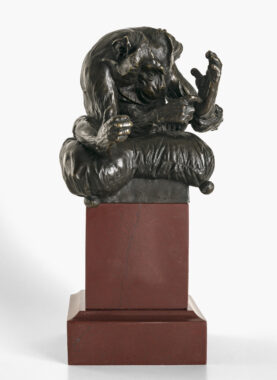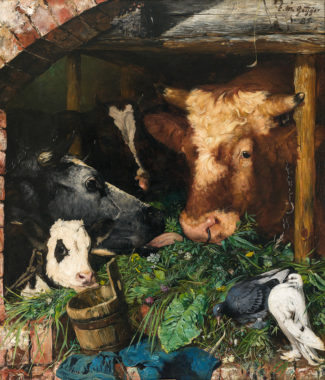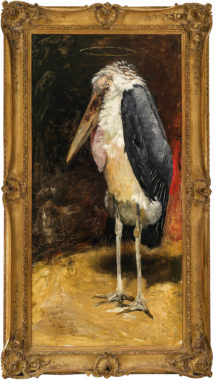Geyger, Ernst Moritz
Sold Artworks
Biography
Ernst Moritz Geyger
1861 Rixdorf, Berlin – 1941 Florence
Ernst Moritz Geyger attended the Berlin Academy of Fine Arts from 1878 to 1883, where he was mentored by Paul Meyerheim. As a professor of animal painting, Meyerheim was one of the leading exponents of his subject and often took his students to the zoological gardens to study the anatomy and behaviour of native and exotic animals in front of living objects.
In 1886, Geyger was awarded a gold medal for his painting Viehfütterung (Cattle Feeding). The unconventional composition of the motif was praised, as was the hyper-realistic style of painting, which was reminiscent of the tradition of the Dutch masters of the 17th century and at the same time perceived as modern. In the spring of 1887, Geyger painted his last painting Weisheit (Wisdom) in just one day. It depicts an almost life-size marabou with a halo and leads on to the animal grotesques that the artist had been working on for some time. In etchings such as Kleine Affendisputation (Small monkey disputation) or Großer Affendisput über die Abstammung der Menschheit (Great monkey dispute about the origins of mankind), Geyger takes up the debate surrounding Charles Darwin’s theories and satirically turns them on their head. In doing so, he approaches the popular monkey painter Gabriel von Max.
Although Geyger enjoyed great success as a painter and graphic artist, he abandoned these two genres in favour of sculpture. His first work is a bronze group depicting a hippopotamus attacked by a lion. Its dramatic composition and masterful chiselling, which the artist executed by hand over many years, earned him great admiration. With the bronze Dornauszieher (Thorn puller), Geyger once again enters the realm of the animal grotesque. It refers to the ancient marble sculpture Il Spinaro, now in the Vatican Museums, in which the boy pulling a thorn out of the sole of his foot is replaced by a pig monkey on a velvet cushion. Geyger’s main sculptural work, on the other hand, shows an antique naked warrior who has drawn his bow to the hilt and is about to shoot his arrow at a distant target. With this pathos-laden ideal of masculinity, Geyger’s archer strikes a chord with the times. In 1900, Kaiser Wilhelm II acquired a cast of the statue, almost five metres high, for the palace gardens of Sanssouci, and smaller versions were soon erected in prominent locations in German cities.
The fact that Geyger was forgotten during his lifetime despite his remarkable successes in all areas of the visual arts is probably due to a scandal that does not show him in a good light. His close friend for a time, Max Klinger, accused him of embezzling the funds made available to him to found the private German Academy in Florence. At the end of the 1890s, Geyger and Klinger fought out their dispute in public via the press. Although a trial held between 1901 and 1903 for libel and slander ended in a settlement, Klinger was generally considered to have emerged victorious. Geyger’s reputation was so badly damaged that he withdrew to Florence, where he had already lived intermittently since the late 1880s. A few years later, with the support of several patrons, Klinger founded the Villa Romana there, which still sponsors German art scholarship holders today.
PDF Download

